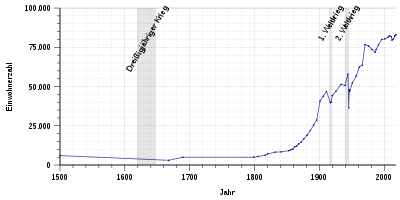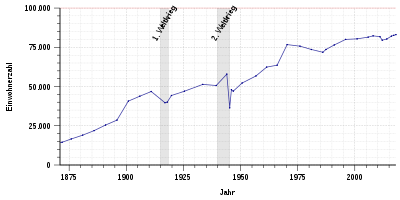Worms, Germany
![]()
The title of this article is ambiguous. For other meanings, see Worms (disambiguation).
Template:Infobox Municipality in Germany/Maintenance/Type unknown
Worms [vɔʁms, in dialect vɔms] (lat. Wormatia, Borbetomagus or Civitas Vangionum) is an independent city in the southeastern Rhineland-Palatinate and lies directly on the left bank of the Rhine. The medium-sized centre with the partial function of a regional centre is located on the edge of the Rhine-Neckar and Rhine-Main metropolitan regions. Due to this location, it is simultaneously assigned to the planning region Rheinhessen-Nahe and the metropolitan region Rhein-Neckar (in which the planning region Rheinpfalz has been merged).
The current inhabitants of the city founded by the Celts are vying with Augsburg, Trier and Kempten for the title of Germany's oldest city. Worms is the German representative in the Most Ancient European Towns Network.
Worms is known as the city of the Nibelungs and Luther and for its cathedral, which is one of the three Romanesque imperial cathedrals along with the cathedrals of Mainz and Speyer. Worms (Yiddish ווירמייזא Wermajze), one of the three SchUM cities, was also a center of Ashkenazi Jewish culture in Germany.

The Worms Cathedral St. Peter

Logo of the "Nibelungenstadt Worms
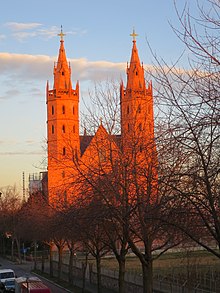
Liebfrauenkirche north of the old town
Geography
Geographical position
Worms is located in the eastern part of Rhineland-Palatinate in the Upper Rhine Plain. It is located in the southeastern part of the Rheinhessen region between Mainz (about 40 kilometres north) and Ludwigshafen (about 20 kilometres south) on the left, western bank of the Rhine. In the northern part of the city, the Pfrimm flows into the Rhine, while the Eisbach (also called Altbach here), which also flows into this stream, flows through the southern parts of the city. In the extreme southeast of the city runs the lower reaches of the Eckbach, which also flows into the Rhine.
To the southwest, 15 km away, lie the foothills of the Palatinate Forest, to the west the hilly landscape of the Wonnegau, and on the other side of the Rhine, the Hessian part of the Odenwald adjoins the plain.
The lowest point of Worms is at 86.5 m above sea level near the northern district of Ibersheim on the former river island of Ibersheimer Wörth, the highest point is at 167 m on the western city boundary between the district of Pfeddersheim and the adjoining Nieder-Flörsheim to the west, directly on Nieder-Flörsheimer Straße (state road 443).
Catchment area
As a medium-sized centre, Worms is directly assigned to the Wonnegau region with the municipalities of Eich, Monsheim and Wonnegau. The city's catchment area also includes parts of the Hessisches Ried and the northern Vorderpfalz.
Worms is located in the north of the Rhine-Neckar metropolitan region and in the south-west of the Rhine-Main region and is also considered a link between these conurbations due to its location. Therefore, in terms of spatial planning, the city belongs to both the Rhine-Hesse-Nahe planning region and the Rhine-Palatinate planning region, which is supervised by the Rhine-Neckar Regional Planning Association.
City breakdown
Worms is divided into eight boroughs with 19 districts. The 13 incorporated districts (subdivisions of the city districts 4 to 7), which at the same time form districts in addition to the central district of Worms, each have a local council, local head and local administration as local districts. With great self-confidence, they attach great importance to the preservation of their typical character. District-related wine festivals take place, for example, in the Herrnsheim castle courtyard of the former barons of Dalberg or at the medieval town walls of Pfeddersheim.
| Districts of Worms, according to city districts | ||||||||
| District | Area | Inhabitants | Location to the city centre | incorporated | District key | Postal code | Telephone area code | |
| City district 0 City centre | ||||||||
| 01 City centre | 0086 | 08.735 |
| - – | 073911 | 67547 | 06241 | |
| City district 1 City area south | ||||||||
| 11 City centre south | 0261 | 05.283 | bordering to the south | - – | 073911 | 67547 | 06241 | |
| 12 Karl Marx housing estate | 0643 | 01.117 | south of the centre (3 km) | - – | 073911 | 67547 | 06241 | |
| City district 2 City area north | ||||||||
| 21 City Centre North | 0723 | 09.725 | adjoining to the north | - – | 073911 | 67547 | 06241 | |
| City district 3 Southwest | ||||||||
| 31 City Centre West | 0155 | 10.001 | bordering to the west | - – | 073911 | 67549 | 06241 | |
| 32 Downtown Southwest | 0176 | 02.057 | bordering to the southwest | - – | 073911 | 67549 | 06241 | |
| Municipality 4 Western Suburbs | ||||||||
| 41 Pfiffligheim | 0393 | 03.386 | west of the centre | October 1, 1898 | 073913 | 67549 | 06241 | |
| 42 Hochheim | 0242 | 03.538 | northwest of the center | October 1, 1898 | 073909 | 67549 | 06241 | |
| 43 Neuhausen | 0185 | 10.508 | north of the center | April 1, 1898 | 073910 | 67549 | 06241 | |
| 44 Herrnsheim | 1217 | 06.270 | in the north of the city (5 km) | April 1, 1942 | 073903 | 67550 | 06241 | |
| 45 Leiselheim | 0259 | 02.104 | outside in the west (4 km) | April 1, 1942 | 073914 | 67549 | 06241 | |
| Municipality 5 Suburbs Southwest | ||||||||
| 51 Horchheim | 0575 | 04.795 | southwest of the centre (4.5 km) | April 1, 1942 | 073908 | 67551 | 06241 | |
| 52 Weinsheim | 0417 | 02.780 | in the southwest of the city (4 km) | April 1, 1942 | 073912 | 67551 | 06241 | |
| 53 Wiesoppenheim | 0354 | 01.733 | outside in the southwest (5,5 km) | June 7, 1969 | 073907 | 67551 | 06241 | |
| 54 Heppenheim | 1126 | 02.207 | outside in the southwest (9 km) | June 7, 1969 | 073906 | 67551 | 06241 | |
| Municipality 6 Western outskirts | ||||||||
| 61 Pfeddersheim | 1187 | 07.025 | outside in the west (7 km) | June 7, 1969 | 073905 | 67551 | 06247 | |
| 62 Abenheim | 1090 | 02.512 | outside in the northwest (10 km) | June 7, 1969 | 073904 | 67550 | 06242 | |
| Municipality 7 Northern Suburbs | ||||||||
| 71 Rheindürkheim | 0812 | 02.923 | outside in the north (8 km) | June 7, 1969 | 073902 | 67550 | 06242 | |
| 72 Ibersheim | 0972 | 00.714 | outside in the north (13 km) | June 7, 1969 | 073901 | 67550 | 06246 | |
see also: List of places in the independent city of Worms
Climate
Worms belongs to the climatic zone of the middle latitudes. The climate is continental. Due to its location in the Upper Rhine Plain between the Palatinate Forest and the Donnersberg in the west and the Bergstrasse and the Odenwald in the east, Worms is one of the warmest and driest places in Germany.
Air temperature
The long-term average of air temperature for the period 1951 to 1980 is 10.3 °C. In recent years, an increase in the annual mean air temperature has been observed. In 2008, for example, the averaged air temperature at Hagenstraße was 12.2 °C, while an averaged air temperature of 11.3 °C was measured five kilometres further west in Worms-Leiselheim during the same period. The air temperature for 2007 (averaged) was 12.7 °C at Hagenstrasse and 11.7 °C at Leiselheim. The higher average value of +1K of the annual mean temperature at Hagenstraße compared to the weather station Worms-Leiselheim is mainly based on the mostly warmer inner-city temperature values. In Worms the warmest month is currently July with 24 degrees Celsius daytime temperature. In contrast, the coldest month is January with an average of 3 degrees Celsius. The average daily high temperature in Worms is 14 degrees Celsius. At night, the average is 4 degrees Celsius.
Precipitation
The average precipitation for the period from 1961 to 1990 is 608 mm. Precipitation falls mainly in the months of May, June and July. In 2008, the annual precipitation at Hagenstraße was 492.2 mm, while an annual precipitation of 529.4 mm was measured five kilometres further west in Worms-Leiselheim during the same period.
The precipitation amounts for the year 2007 (averaged) - Hagenstraße 545.8 mm - Leiselheim 622.6 mm. The precipitation levels are low. They are in the lower quarter of the values recorded in Germany. Lower values are recorded at 23 % of the measuring stations of the German Weather Service. The driest month is February, the most precipitation falls in July. In July there is 2 times more precipitation than in February. Precipitation varies relatively strongly. Lower seasonal variations are recorded at 69 % of the measuring stations in Germany.
Sunshine duration
The long-term average (1951-1980) is 1709.7 hours. In the past years an increase of the annual average of sunshine hours was observed in Leiselheim. In 2007 there were 2007 hours of sunshine, a deviation from the long-term average of + 297.3 hours or + 17.4 %, in 2008 1886 hours were determined. This is a deviation from the long-term average of + 176.3 hours or + 10.3 %. In 2009 and 2010 the deviations were even more striking, + 343.3 hours or + 20.1 % (2009) and + 357.3 hours or + 20.9 % in 2010. Currently the sunshine duration is about 4 hours per day.
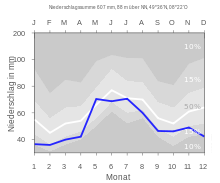
Precipitation mean values of Worms for the period from 1961 to 1990
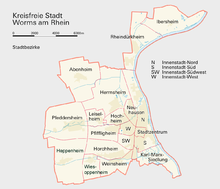
The 19 districts of Worms

Worms with Nibelungen Bridge, Cathedral, Rhine and Rhine Promenade
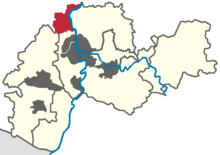
Worms within the Rhine-Neckar Metropolitan Region
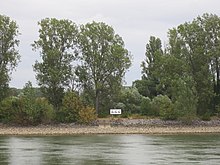
River kilometer 444 of the Rhine in Worms
Population
Population development
In its heyday around 1500, Worms had about 6,000 inhabitants. Due to the destruction during the Thirty Years' War (1618-1648) and a plague epidemic in 1666/67, the number of inhabitants dropped to only 3,000. With the industrialization in the 19th century, the population growth accelerated. While in 1800 only 5,000 people lived in the town, in 1900 it was already over 40,000. The incorporation of several towns in 1969 brought an increase of 15,000 people to 78,000 inhabitants.
As of 31 December 2020, the official population for Worms was 83,459, according to figures from the Rhineland-Palatinate Statistical Office, making Worms the sixth largest city in Rhineland-Palatinate and the fourth largest in the Rhine-Neckar Triangle. Worms has a proportion of foreigners of 16.3%. The proportion of pupils with a migration background in general education schools in Worms was 22 % (school year 2012/13). This tops the list in a comparison of cities in Rhineland-Palatinate, after Ludwigshafen and Mainz. In day care facilities, over 49 % of children had a migration background at the beginning of 2015. In 2005, Worms was in second place among the independent cities behind Mainz (41.2 years) with an average age of 41.5 years. This means that Worms has a relatively young population, even in a nationwide comparison. In Rhineland-Palatinate the average age is 41.6 years and in Germany 41.8 years.
The following overview shows the population figures according to the respective territorial status. Up to 1820, these are mostly estimates, thereafter census results (¹) or official updates of the State Statistical Office. From 1871 onwards, the figures refer to the "local population", from 1925 onwards to the resident population and since 1987 to the "population at the place of principal residence". Before 1871, the number of inhabitants was determined according to non-uniform survey procedures.
|
|
| ||||||||||||||||||||||||||||||||||||||||||||||||||||||||||||||||||||||||||||||||||||||||||||||||||||||||||||||||||||||||||||||
¹ Census result
Confession statistics
According to the 2011 Census, 37.3% of residents in 2011 were Protestant, 27.9% were Roman Catholic, and 34.8% were non-denominational, belonged to another religious community, or did not specify. The number of Protestants and Catholics has since declined. Currently (as of May 31, 2021), of the residents, 28.2% are Protestant, 23.3% are Catholic, and 48.5% are non-denominational, belong to another religious community, or did not specify.
Search within the encyclopedia
